Effect of Annealing Treatment On Properties Of Fe-Si-B-Cu Amorphous Nanocrystalline Alloys
1. Soft magnetic properties of Fe based amorphous nanocrystalline alloy soft magnetic materials
Compared with Permo alloy, silicon steel, ferrite, etc., Fe-based amorphous nanocrystalline alloy has more excellent comprehensive soft magnetic properties, such as higher Bs, higher permeability, lower Hc, lower iron loss, etc. The amorphous/nanocrystalline dual-phase alloy is obtained by crystallization annealing. The internal stress can be released during the annealing process, so as to further optimize the soft magnetic properties of the alloy. The Bs of Fe-based amorphous nanocrystalline alloy ranges from 1.5 to 1.9 T, and its Bs is high because the content of Fe element is above 80 at.%. The soft magnetic properties of typical Fe-based amorphous nanocrystalline alloys are shown in Table 1.1. The resistivity of Fe-based amorphous nanocrystalline alloy material is higher, while the iron core of the magnetic core is lower, which is 1/3~1/5 of the ordinary silicon steel sheet. Replacing silicon steel as a distribution transformer can reduce the iron loss by 60~70%. The production process is simple and environmentally friendly. Generally speaking, the production process of traditional crystalline soft magnetic alloys (such as silicon steel) is more complicated, while amorphous alloys only adopt the one-time blasting molding technology. Compared with traditional crystalline soft magnetic alloys, it has the characteristics of short process, simple process, energy saving and lower cost, reducing the emission of “three wastes”, and the production of nanocrystalline transformer will be more environmentally friendly. Therefore, the invention of rapid solidification technology is a revolution in metallurgical technology. Fe-based amorphous nanocrystalline alloy has high thermal stability, and the crystallization temperature is generally 450~600 °C, which can adapt to the application temperature of transformer environment. Moreover, the Curie temperature of nanocrystalline materials is greater than 400 °C, which is stable at high frequency, ensuring a wide range of application. In addition, because Fe based amorphous nanocrystalline alloy materials are in metastable state and tend to crystallize at a certain temperature, the magnetic properties of nanocrystalline alloy materials will decrease with time. However, applications and experiments at home and abroad have proved that nanocrystalline alloy materials are reliable when used at 150 °C. Therefore, Fe – based amorphous nanocrystalline alloy materials are safe in terms of aging stability. After proper treatment, the magnetic properties of Fe-based amorphous nanocrystalline alloy materials can be basically restored by the impact of strong magnetic field. Fe-based amorphous nanocrystalline alloys have high mechanical stability and wide frequency adaptation range. Different Fe-based amorphous nanocrystalline alloys have different magnetic induction and Curie temperature points, which are suitable for different occasions.
At present, Fe based amorphous nanocrystalline alloy soft magnetic materials have been widely used in distribution transformers, transformers, reactors and other components, involving power supply, switching power supply, instrumentation, vehicle electronics, mining/petroleum and solar energy and other fields. As a new kind of green functional materials, Fe based amorphous nanocrystalline alloy has infinite possibilities in the fields of application, such as pharmaceutical, atomic motion of condensed matter, space fixed point observation, optics and other fields. Antai Technology Co., Ltd. has broken through many core technologies of continuous production of amorphous strip, and has built 100-ton, 000-ton and 10,000-ton Fe based amorphous alloy strip production lines, with a stable production strip width up to 340 mm. Since 2015, the output of amorphous alloy strip in China has increased significantly, about 30,000 tons for Antai Technology and 18,000 tons for Qingdao Yunlu. In 2016, the annual output of 5 domestic enterprises can reach 10,000 tons, and the actual output of Antai, Yunlu and other enterprises has reached or close to 30,000 tons. China has become an international leading country in the production of Fe-based amorphous/nanocrystalline alloy strip and related products. In response to the market demand, China is developing special Fe based soft magnetic amorphous/nanocrystalline alloy soft magnetic materials to further expand the application field. At the same time, aiming at high frequency, high efficiency and energy saving motor and other high-end products, the development of high performance amorphous/nanocrystalline soft magnetic alloy materials and related products processing and manufacturing core technology, to meet the market and high-tech field development requirements.
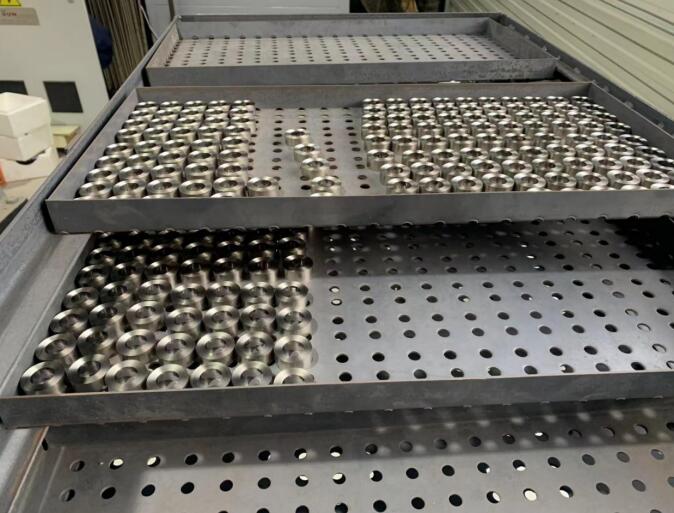
2. Annealing process of Fe based amorphous nanocrystalline alloy soft magnetic materials
Fe-based amorphous nanocrystalline alloy is a kind of soft magnetic material with small size α-Fe nanocrystalline grains obtained by crystallization annealing of Fe-based amorphous alloy. In addition to the alloy composition, heat treatment is also a key factor affecting the soft magnetic properties of Fe-based amorphous nanocrystalline alloys. The annealing process of Fe based amorphous nanocrystalline alloy can be divided into isothermal annealing, step annealing, electric/magnetic nanocrystallization and hot isostatic pressure crystallization. Different annealing processes of the alloys have different effects on the properties of the alloys, especially the bending ductility. Many Fe-based amorphous nanocrystalline alloys will become brittle after annealing.
The traditional annealing method for Fe based amorphous nanocrystalline alloy soft magnetic materials is isothermal annealing. The amorphous strip sample is usually placed in a vacuum quartz tube, and isothermal annealing at the temperature set in the tube furnace for a certain period of time. After that, the nanocrystalline alloy is finally obtained through water quenching, air cooling or furnace cooling. The annealing temperature, holding time, heating rate, cooling rate and other parameters have great influence on the grain size and volume fraction of nanocrystals obtained after annealing. Dong et al. [45] studied the effect of holding time after annealing on (Fe83.3Si4B8P4Cu0.7) 100-xAlx alloy. The results showed that with the extension of holding time, the grain size of the alloy gradually increased, and the content of crystalline phase also increased. Kolano et al. [46] systematically studied the effects of different cooling rates on the grain size and soft magnetic properties of Fe73.5Si13.5-xBxCu1Nb3 (x = 7,9) nanocrystals. The results showed that the grain size of nanocrystals obtained at annealing temperature of 548 °C and holding for 0.5 h was inversely proportional to the cooling rate. When the cooling rate is 35 K/min, the grain size is the smallest. When the holding time is 1 h, the grain size is larger and does not change with the increase of the cooling rate. Rapid annealing is to wrap the alloy strip in aluminum foil, and put it into preheated fine sand (30~50 mesh) for 30 s at the set temperature, and then put it into the fine sand at room temperature to cool. Rapid annealing is mainly used to obtain excellent soft magnetic properties and good bending ductility of Fe based amorphous nanocrystalline alloy soft magnetic materials at the same time by using the characteristics of high temperature, low time and low temperature delay. Meng et al. [47] annealed the prepared Fe83Si4B10P2Cu1 amorphous strip at 520 °C for 30 s, and finally obtained Fe83Si4B10P2Cu1 amorphous nanocrystalline alloy strip with Bs as high as 1.82 T and Hc as low as 6.2 A/m. Compared with traditional annealing, fast annealing can improve the soft magnetic properties and bending ductility of Fe-based amorphous nanocrystalline alloys.
The results show that the crystallization heat of Fe-based amorphous alloys can be released in advance after annealing at 520 °C for 20 min and then at 560 °C for 40 min, compared with one-step crystallization annealing at 560 °C for 40 min. So the properties of amorphous alloys can be improved by controlling annealing temperature effectively. It was heated at 3 °C/min to 500-530 °C until the crystallization transformation was completed. Then, it was heated at 3 °C/min to 550-570 °C for 1 h while applying a DC magnetic field, and then cooled to room temperature at a cooling rate of 3-5 °C/min. This new technology can effectively control the phenomenon of heat shock caused by crystallization of the core, improve the performance stability of the core, and ensure the qualified rate of mass production of the core. Step annealing is mainly used to improve the nucleation rate of amorphous materials in the process of crystallization, so as to increase the number density of nanocrystalline grains and reduce the grain size.
Magnetic field annealing is the addition of an external magnetic field in the process of heat treatment, which can be regarded as giving the alloy a magnetically induced anisotropy. There are different pairs of atoms in magnetic alloys, and their dipoles interact with each other differently. Therefore, in thermal activation systems with magnetic fields, the pairs of atoms tend to be arranged in the direction of the lowest total energy. When the magnetic field annealing is finished, the temperature of the whole system drops, and the atomic diffusion process also ends. The ordered atomic arrangement structure remains in the sample, and the permeability of the material changes significantly. According to the magnetic field annealing process can be divided into: transverse magnetic field annealing, longitudinal magnetic field annealing, rotating magnetic field annealing and pulse magnetic field annealing. The magnetic domains of Fe-based amorphous nanocrystalline alloys rotate along the direction of the external magnetic field during magnetic field annealing. After annealing, the atomic pairs with ordered directions will keep the orientation during magnetic field annealing. Low frequency pulsed magnetic field treatment is a new process of electromagnetically/magnetically induced nanocrystallization at room temperature. The atomic periodic vibration caused by pulsed magnetic field treatment increases the initial atomic energy, reduces the nucleation barrier and increases the nucleation rate. Kwon et al. systematically studied the influence of magnetic field annealing on the magnetic properties of Fe87-xSixB9Nb3Cu1 amorphous alloy system. After magnetic field annealing, the soft magnetic properties of the alloy system were improved, and higher Bs and permeability and lower core loss were obtained.
Joule thermal annealing uses current to generate Joule heat to heat alloy materials. The annealing time is short, and the toughness of the alloy after annealing is good. In Joule thermal annealing process, Hc of alloy materials will change with the increase of holding time, and the increase of holding time and current density will also increase the volume fraction of crystalline phase. However, due to the shortcomings of short time and difficult temperature control of joule thermal annealing, it is still in the laboratory research stage and has not been applied to the industrial production of amorphous soft magnetic alloys. It is well known that increasing the volume fraction of α-Fe nanocrystalline particles can improve the Bs of the alloy, and refining the grain size can reduce the Hc of the alloy. Conventional crystallization process is difficult to achieve both increasing the volume fraction of nanocrystalline particles and refining the grain. The results show that the crystallization behavior of amorphous alloys will be changed and the formation of high density crystalline phase will be promoted when annealed under high pressure. Fe86Zr7B6Cu1 (pressure 100 MPa, crystallization temperature 600 °C) and Fe86Cu1B13 (pressure 150 MPa, crystallization temperature 410 °C) were annealed for 1 h respectively by hot isostatic annealing process. Compared with the traditional method, The hot isostatic annealing method increases the volume fraction of α-Fe nanocrystalline particles with bcc structure and refines the grains, thus effectively increasing Bs and decreasing Hc.
It can be found that no matter which annealing method is used, the main purpose is to improve the soft magnetic and mechanical properties of Fe-based amorphous nanocrystalline alloy by controlling the grain size and distribution of nanocrystalline and the volume fraction of crystallized phase in the annealing process. Most researchers mainly use annealing to improve the soft magnetic properties of Fe-based amorphous nanocrystalline alloys, and study the effects of different annealing methods, annealing temperature, heating rate, annealing medium and cooling methods on the properties of Fe-based amorphous nanocrystalline alloys. In recent years, rapid annealing and isothermal annealing are mainly used in laboratories, while magnetic field annealing and isothermal annealing are mainly used in enterprises to improve the soft magnetic properties of Fe based amorphous nanocrystalline alloys.
3. Effect of annealing treatment on microstructure and properties of Fe-Si-B-Cu amorphous nanocrystalline alloys
The heat treatment of Fe based amorphous nanocrystalline alloy mainly includes magnetic field annealing, rapid annealing, isothermal annealing, Joule heat annealing and so on. In recent years, rapid annealing, magnetic field annealing and isothermal annealing are mainly used in laboratory, and magnetic field annealing is mainly used in industry, so that the alloy can obtain higher permeability. Because the components designed in this paper do not contain volatile P element, so the traditional isothermal annealing method is adopted. Generally speaking, the annealing temperature of Fe-based amorphous nanocrystalline alloys can be selected between Tx1 and Tx2. However, in order to facilitate the control of grain size, the annealing temperature in this paper is selected near Tx1 temperature. Theoretically, when the annealing temperature is lower than Tx1 temperature, amorphous crystallization will not occur. However, due to the existence of atomic clusters and short procedures on the amorphous matrix, the amorphous alloy still precipitates α-Fe nanocrystalline grains in the crystallization process when annealed at a temperature lower than Tx1, and finally obtains the crystalline structure [84]. If the annealing time is too long, the grains will overgrow, the annealing time is too short, and the precipitated α-Fe phase is not complete. Therefore, it is of great significance to select the appropriate annealing time for the nanocrystalline alloy to obtain excellent comprehensive soft magnetic properties. If the grain size is large, it can be considered to shorten the annealing time to obtain smaller nanocrystalline grains. The size and distribution of grain size affect the soft magnetic properties of Fe-based amorphous nanocrystalline alloys. In order to obtain Fe-based amorphous nanocrystalline alloys with excellent soft magnetic properties, this paper combined with the DSC curve of Fe85Si6-xB8Cu1Cx amorphous alloy bands in quenching state in FIG. 3.2. Finally, the annealing temperature range was Tx1±20 °C, the annealing time was 10 min, the heating rate was 10 °C/min, and the cooling mode was selected as the furnace cooling to 100 °C and then air cooling. In order to remove the internal stress, all the alloy strips in this paper were first held at 300 °C for 1 h before the formal annealing.
3.1 Effect of annealing temperature on microstructure and properties of Fe-Si-B-Cu-C amorphous nanocrystalline alloys
For Fe-based amorphous nanocrystalline soft magnetic alloys, it is very important to control the precipitation of α-Fe nanocrystalline grains during annealing. The relationship between the microstructure of Fe-based amorphous nanocrystalline alloys and the soft magnetic properties has been established in the random anisotropic model. In other words, the uniform distribution of fine α-Fe grains on the amorphous matrix is helpful for the nanocrystalline alloys to obtain good soft magnetic properties. A large number of literatures have studied the effects of annealing temperature, annealing time and heating rate on the microstructure and properties of alloys. The microstructure and element distribution of Fe84.75Si2B9P3C0.5Cu0.75 amorphous nanocrystalline alloy under different annealing conditions were studied, and the related mechanism of grain refinement and nanostructure stabilization of Fe-based amorphous nanocrystalline soft magnetic alloy was revealed. The results show that annealing at lower temperature, The alloy can retain smaller α-Fe grains for a longer annealing time, and the metal elements are enriched around the α-Fe grains. With the increase of annealing temperature or annealing time, α-Fe grains will precipitate the second phase on the interface of amorphous matrix, which leads to the rapid coarsening growth of α-Fe grains through aggregation. The effect of isothermal annealing on the abnormal crystallization behavior and soft magnetic properties of Fe-Si-B-P-Cu alloy (Nanomet) has been studied. The results show that the formation of crystal nuclei takes a certain time when the annealing temperature is below Tx1, while the formation of crystal nuclei can be achieved in a shorter annealing time when the annealing temperature is above Tx1. Bs and Hc of amorphous nanocrystalline alloys are particularly sensitive to annealing temperature and holding time, and Hc is mainly affected by nucleation process. In conclusion, the soft magnetic properties of Fe-based amorphous nanocrystalline alloys are greatly affected by annealing temperature and annealing time, so it is significant to study the effects of annealing temperature and annealing time on the microstructure and properties of the alloys.
3.1.1 Effect of annealing temperature on phase of Fe-Si-B-Cu-C amorphous nanocrystalline alloy
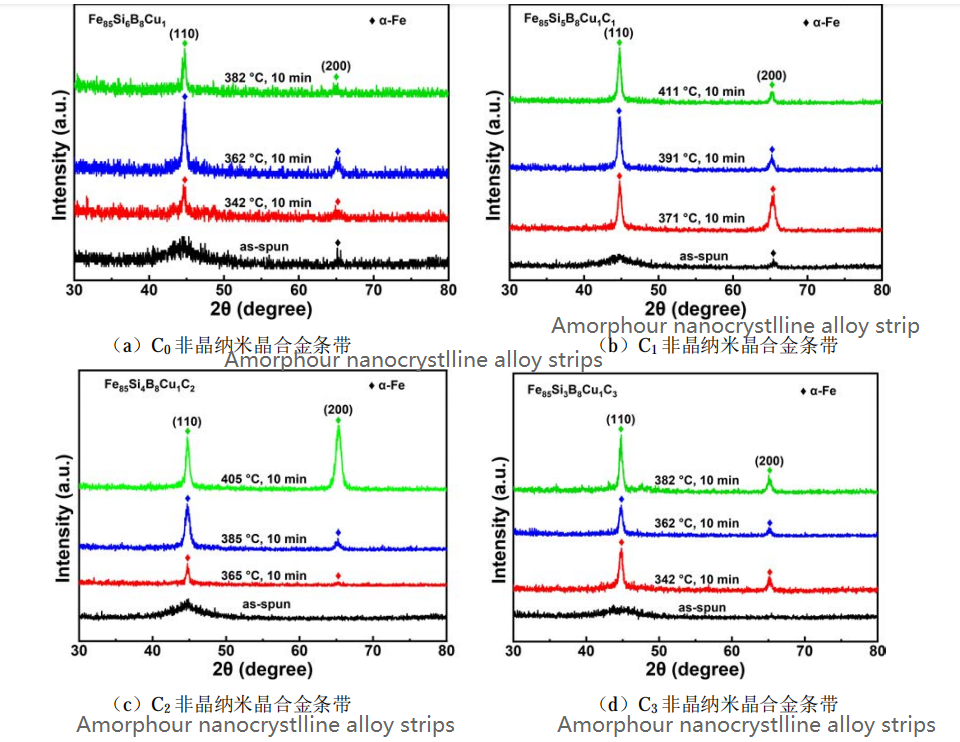
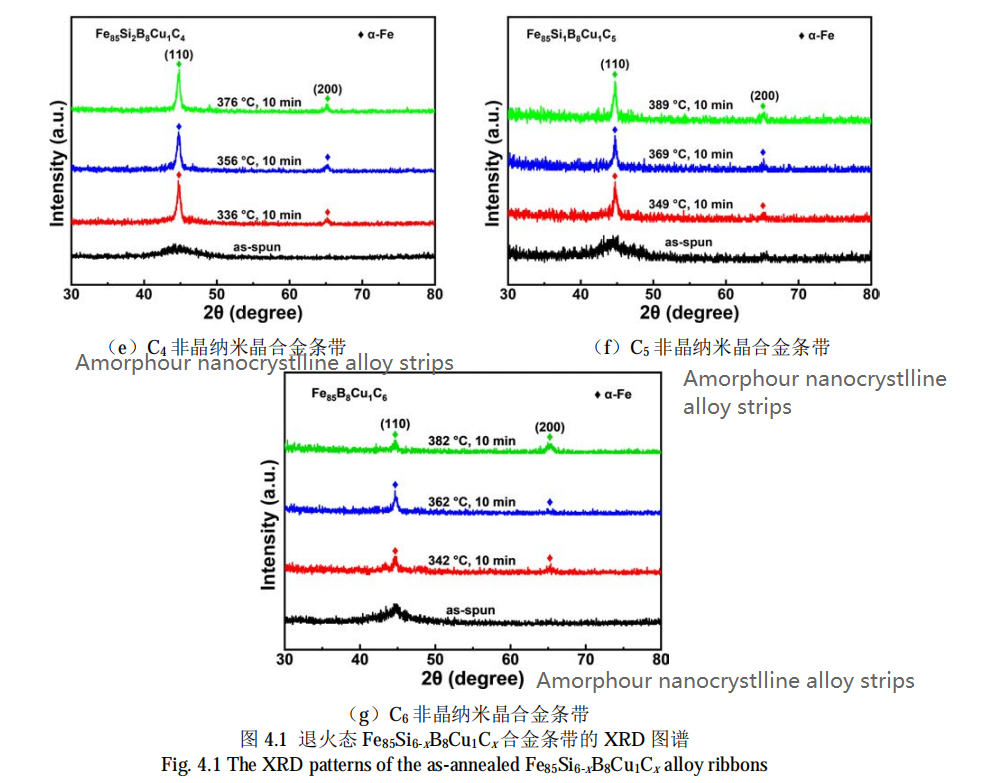

3.1.2 Effect of annealing temperature on microstructure of Fe-Si-B-Cu-C amorphous nanocrystalline alloy



3.1.3 Effect of annealing temperature on soft magnetic properties of Fe-Si-B-Cu-C amorphous nanocrystalline alloys


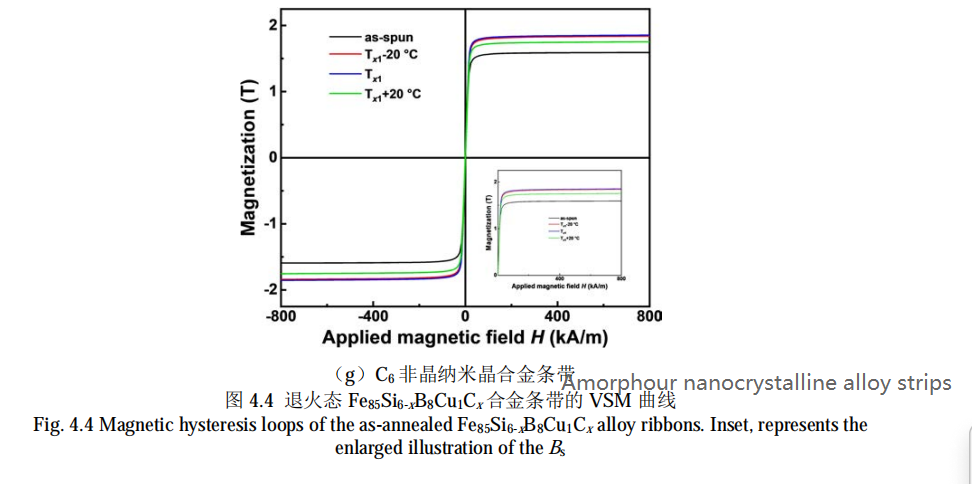
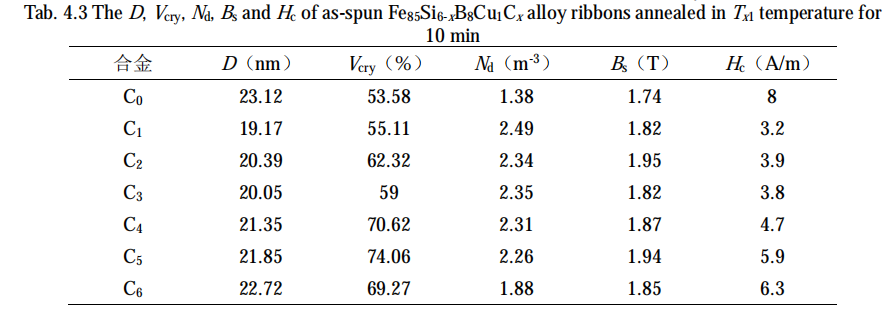
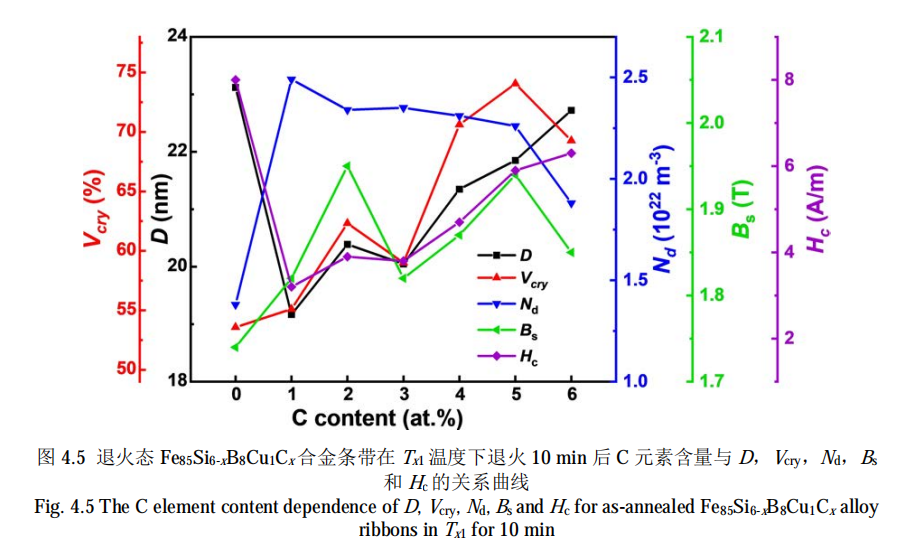
3.2 Effect of annealing time on microstructure and properties of Fe-Si-B-Cu-C amorphous nanocrystalline alloys
As we all know, annealing temperature, annealing time, heating rate and cooling mode have great influence on the properties of Fe-based amorphous nanocrystalline alloys. Therefore, obtaining α-Fe nanocrystalline grains with small size and uniform distribution is a prerequisite for obtaining excellent soft magnetic properties of Fe-based amorphous nanocrystalline alloys. In order to improve the soft magnetic properties of Fe-Si-B-Cu-C amorphous nanocrystalline alloys and keep the annealing temperature unchanged, the effects of different annealing times on the microstructure and soft magnetic properties were studied.
3.2.1 Effect of annealing time on phase of Fe-Si-B-Cu-C amorphous nanocrystalline alloy
3.2.2 Effect of annealing time on microstructure of Fe-Si-B-Cu-C amorphous nanocrystalline alloy
3.2.3 Effect of annealing time on soft magnetic properties of Fe-Si-B-Cu-C amorphous nanocrystalline alloys.
4.Conclusion
In this paper, Fe85Si6-xB8Cu1Cx (x = 0,1,2,3,4,5,6) amorphous alloy strips were prepared by single roll strip method. By means of XRD, DSC, VSM and TEM, The effects of annealing process on the microstructure and properties of Fe85Si6-xB8Cu1Cx (x = 0~6) alloy strips were systematically studied. The following conclusions were obtained:
(1) When Fe85Si4B8Cu1C2 amorphous bands were annealed at 385 °C for 10 min, the volume fraction Vcry of the precipitated α-Fe nanoparticles was up to 62.32%, the average grain size D was 20.39 nm, and the density number Nd was 2.34×1022 m-3. The alloy obtained excellent soft magnetic properties, Bs up to 1.95 T, Hc as low as 3.9 A/m.
(2) After annealing at 356 °C for 5 min, the average grain size of Fe85Si2B8Cu1C4 alloy strip is 20.96nm, Vcry is 66.54%, Nd is 2.30×1022 m-3, and excellent soft magnetic properties are obtained. That is Bs as high as 1.96T, Hc as low as 4.2A /m.

Effect 0f Annealing Temperature On Nanocrystalline Incoloy800 Nitriding Process Specification And Operation Kerosene Vapor Phase Drying Process For 44MVA Transformer

Contact us
Your email address will not be published. Required fields are marked *